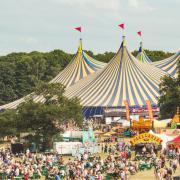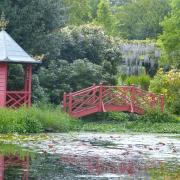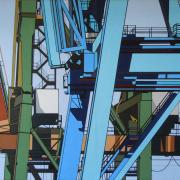Let’s give a shout out to the humble building brick - not just any old brick but our very own Suffolk brick, made from Suffolk earth.
Bricks, on their own, don’t really do a lot. They're simply a lump of earth shaped into a cuboid and fired. But bricks become walls which become our homes, workplaces, buildings of local and national importance, and part of our history.
Suffolk became one of the most prosperous industrial counties in Britain thanks, in no small part, to its brickearth, a clayey alluvium particularly suitable for making bricks. In the 19th century almost every village, and certainly every town, in Suffolk had its own brickworks. The evidence is still there in the countryside where the bustling brick industry left behind reminders in the form of overgrown pits in fields and woods, and sometimes the ruins of disused brick kilns.
Brickearth is essentially a soft rock material, a silty clay which contains some sand. Chalk underlies the whole county of Suffolk and, over time, different deposits have varied the composition of brickearth. Overlying the chalk in south Suffolk and coastal areas are sands and clays deposited about 50 million years ago - this is 'London clay', so called because it is the type that lays 132 metres thick under the city of London, and supports tunnels and deep foundations.

Towards the Suffolk coast, this was overlaid by sands and clays known as crag about 2 million years ago, followed by glacial clays 50,000 years ago. Deposits laid 10,000 years ago in our rivers and estuaries will be the brickearth of the future.
The traditional way of making Suffolk bricks was strict. When brick clay was dug from the ground it was tested, and a pit established. In the pit, the clay was mixed to the right consistency then tempered by weather and water underfoot for a couple of days. It was then thrown into wooden moulds to form that familiar brick shape.
The moulds were turned into barrows and taken to a flat south-facing field to dry for precisely two days and two nights, being turned occasionally to helping with drying. The bricks were then stacked in rows, one on top of the other, and left to dry for up to three months. Once dry, the bricks were 'fettled' (trimmed) and stacked to form a kiln in order to bake them. The sight, sounds and smell of all this would have been intensely familiar up to the first half of the 18th century. Imagine the aroma wafting from the kilns, fuelled mainly by timber, with bricks being fired at 1,040C continuously for three days and nights.

Brick colouring and shades would have been a journey of discovery, and this is where some science comes in to play. Red bricks are the result of higher amounts of iron oxide in the earth, whereas limestone and chalk earth create a white brick, shade and colour also dependent on the temperature of the kiln.
There were three main brickworks in the immediate Bury St Edmunds area where the brickearth was mainly limestone and chalk. Woolpit Brickworks, which operated for 400 years, was widely known for its 'Woolpit Whites'. During the custodianship of The Wright family, who ran brickworks throughout Victorian era, these bricks were described as "Being a very white and durable kind of brick, equal in beauty to stone". The builders of both the Angel Hotel and St Johns Church in Bury St Edmunds must have agreed, as these familiar landmarks were built from Woolpit Whites.

Suffolk brickmaking achieved far greater significance in the mid-19th century as brickmakers made use of the rivers and railways. Suffolk bricks were sent to London to create some extremely well-known buildings. One of the largest brickmakers in south Suffolk, Allen’s of Ballingdon, sent both white and red bricks down the river Stour by Lighter, a type of flat-bottomed barge, where they were transferred at Mistley Quay onto sailing barges and transported to London to be used in the construction of Liverpool Street Station, The Royal Albert Hall, and the Kensington museums.
Locally, in 1866 Ipswich brickmaker and builder Edward Gibbons was chosen as sole builder of the 'new' town hall on the Cornhill in Ipswich. While his own bricks were used for some interior work, the exterior was designed in mock Venetian style which meant importing a yellowish bath stone from Nottinghamshire, as well as red stone for the pillars and pilasters.

For much of the 1800s and early 1900s, Gibbons, who was based in St Nicholas Street, Ipswich, employed hundreds of men in brickmaking and building at Ipswich, Shotley, Chilton near Sudbury and the Crown brickworks at Red Hill, Aldham, near Hadleigh.
In the 1850s a generous seam of London brickearth was discovered in an area known as Rushmere Field in Ipswich. Edward immediately worked the earth out, and discovered that the seam extended to the Spring, Foxhall and Rushmere roads areas. Many Victorian and Edwardian houses in these areas are built from this seam of earth by this company, as were several pubs which still stand. One reminder of the brickmaking industry in this part of Ipswich is the Brickmakers Arms pub in Spring Road.

All kinds of structures have been made from bricks over time, one being the water well, essential to life in during Victorian times. There was a unique method of constructing a well. Layers of bricks were arranged in self-reinforcing circles. As the well was dug and soil was removed from the bottom layer of bricks, additional bricks were laid from the top so that the structure gradually sank under its own weight until the desired depth was reached. To ensure stability and that the structure would slide down smoothly, the sides of the well hole needed to be dug completely straight.
The process was fraught with danger. In 1863, Charles Dove, of Ufford, undertook the task of sinking a well at Hasketon brickyard. After a few days of digging through clay and brickearth to softer material, Charles was 54ft down and thought he had nearly reached water. At this point 40ft of the brickwork had been completed.
A lump of rock projecting from the side of the well hole was hindering efforts, so Charlie climbed into a basket on a rope, and set to removing the rock. He created a platform 13ft from the bottom, where he and his colleague, Richard Tyler, worked to remove the obstruction. Then, without warning, running sand caved into the cavity, filling most of the well and burying Charles and Richard. There were hopes that the two men had been able to shelter beneath the platform, but a frantic rescue attempt through the night and a long thunderstorm ended in despair. Both men had perished.

One of the last brickworks to close in Suffolk was Hall Farm Brickworks in Aldeburgh, which began in 1840, and closed under the ownership of WC Reade, who ran the business from 1926-2011. The company was fortunate to have its own railway line running down to a jetty on the bank of the river Alde.
The Bulmer Brick and Tile Company near Sudbury, still makes traditional Suffolk bricks from London clay, which has been extracted from the same seam almost continually since Tudor times. Long may Suffolk bricks continue to build.
*With thanks to Woolpit Museum.



























